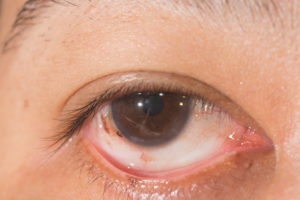Posted by: Metrolina Eye Associates in Eye Health

 OUCH! I got something in my eye. What do I do? What could it be?
OUCH! I got something in my eye. What do I do? What could it be?
Foreign bodies in the ocular surface (cornea, conjunctiva, under eyelid) are a very common form of trauma to the eye. In an ophthalmic office, we see at least one a day and usually more. Emergency rooms also run into this form of trauma in a patient frequently (~2% of all ER visits). The most common foreign body materials found in the ocular surface are: metallic, glass, stone, hair, and various organic materials.
Most commonly, foreign bodies get in the eye from welding and grinding. This will produce a metallic foreign body most likely stuck in the anterior portion of the cornea. Additional common foreign bodies seen in the office are stone/ceramic or organic materials from striking tools and landscaping injuries.
Occasionally, hairs (human/tarantula) are found embedded into the ocular surface. Accidents from guns can cause shrapnel and gunpowder to be embedded into the ocular surface.
So, I got something in my eye. Will it come out on its own and am I at risk of any complications?
Most foreign bodies will not rinse out or come out on their own. They require removal in office by a doctor. The main concerns from these foreign bodies are infections. Metallic foreign bodies can cause formation of a rust ring that can cause an infection and/or inflammatory reaction in the eye. Additionally, organic material in the eye poses a risk for a fungal or atypical bacterial infection.
What should I expect from my visit to the eye doctor when I get a foreign body in my eye?
Once arriving at the office, a detailed history will be asked to determine the mechanism of injury (material, use of safety glasses, type of machine/tools being used, speed of machine, distance from site).
Visual acuities will be measured. The external portion of the eye will be assessed to determine if there is any restriction to movements of the eyes, any external lacerations/injuries. The pupils will be assessed to determine any irregularities suggesting a possible intraocular foreign body.
Topical anesthetic will be instilled in the eyes to help ease the pain and help you to keep your eyes open during the exam.
A slit lamp examination will then be performed to examine the eye with more detail. The doctor will assess the location and depth of the foreign body. During this examination, the following will be ruled out: self-sealing full thickness lacerations, irregularities of the pupil/iris/crystalline lens of the eye and hyphema (blood inside the front of the eye). Eyelids will be everted to look for any foreign bodies hiding under the eyelids.
Intraocular pressure will be measured to determine any asymmetry. An abnormally low pressure in the eye may signify an intra-ocular foreign body.
The eyes will be dilated to examine the back of the eye for any intra-ocular foreign bodies.
At this time, the foreign body will be removed from the eye. The eye will be sufficiently anesthesized with topical anesthetic. The foreign body will be removed with one or a combination of different instruments (spud, forceps, small gauge needle). Superficial foreign bodies stuck under the eyelid can sometimes be removed with a moistened cotton tip applicator.
If there is a rust ring associated with a metallic foreign body, it will need to be removed as well. Often, a small burr is used for removal. Occasionally, if the rust ring is deep, it will be left in the cornea to allow time for the rust to move to the surface prior to removal.
What do I need to do after removal of the foreign body?
An antibiotic will be prescribed for the patient to use to prevent infections. Occasionally, a therapeutic bandage lens will be placed on the eye to reduce pain. Very close follow-up visits will be required to ensure proper healing and help reduce scar formation.
Please, if you happen to get a foreign object in your eye, don’t try to be a hero. Come to Metrolina Eye Associates and let one of our doctors take care of you.